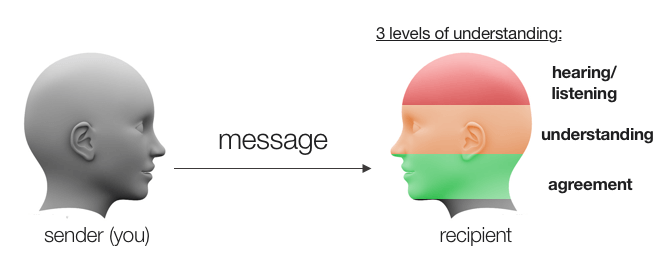Hey there,
I don’t know about you, but for me it has always been communication which posed the biggest challenges in project management.
Not only do you have to communicate A LOT in a project.
You also have to make sure people understand what you’re trying to say.
Easy?
Hmm … when was the last time somebody approached you saying:
- “That’s not what we discussed. We said x …”
- “I thought you meant something else.”
- “I thought you wanted me to do x, and not y …”
- “I didn’t give you my approval for x. We said y …”
Such misunderstandings take a lot of energy to solve. And they create a lot of tension at work.
Because I was so frustrated with my communication mishaps, I was looking for a way to become a more effective communicator.
And I found a great “tool”.
It’s a simple communication model based on communication theory. What it does is to break down communication into different levels of understanding.
The 3 levels of understanding of a message
A message can be a piece of information you pass on to somebody. It can also be a request or an ask for approval.
For whatever you say or ask for, your message must pass all 3 levels of understanding at the person you’re communicating with:

- Level 1: Hearing (or reading) a message
- Level 2: Understanding the message
- Level 3: Agreeing to the message (or request)
I’ll dive into each level later, but …
First let’s get to the essence:
‘Heard’ does not mean ‘understood’.
‘Understood’ does not mean ‘agreed’.
Read the above statement several times. Until you’ve fully grasped it.
Communication problems arise exactly because people don’t make that distinction!
(I pinned that statement to my computer screen to remind me every day)
Let’s dive into each level of understanding and see how you can communicate more clearly.
Level 1: Hearing or reading a message
The first level is when you say something or send an email to someone else.
Unless you are speaking in Chinese and your counterpart understands only Spanish, your message is going to pass the 1st level.
Under what circumstances could communication fail?
The recipient may not have had time to read your message, or he may be out of office. That’s when the message can’t get through to the recipient.
Level 2: Understanding a message
Here it get’s complicated.
Because:
You want the person on the other end to have the same understanding of the message’s content as you have.
In practice, it often doesn’t work out well.
You talk about ‘apples’ while the other person understands ‘pears’.
Most often, the reason is lack of clarity, lack of context, but also failure to make clear requests.
Here are some tips to make sure your message is understood:
- Be crystal clear – as if your life depended on it: Write exactly what you want, and don’t be lazy writing a few extra lines for clarification. Imagine you were kidnapped and had the chance to send a note to a friend who could free you. You’d be as precise as a razor blade.
- Give context: “We are planning to do x”, “We want to accomplish x”, “The reason we are doing this is …”, “We also tried x, but now we want to try y”
- Don’t be shy to make an ask: Many people feel uncomfortable making clear requests. They say “Susan, I wanted to let you know I won’t be in the office next week” when they actually mean: “Susan, could you take over my work next week?”
Don’t EVER assume that people understand the same thing from an email (or a conversation. People understand what they want to understand.
That’s why am particularly careful with emails that go to a larger audience, such as meeting invitations, team updates that include ‘to-do’s or meeting minutes.
I’ll usually have a coworker read my email before I send it out. This way I know what parts to tweak to reduce the risk of misunderstandings.
Once your counterpart has understood the point, the next step is:
Level 3: Agreement
You want other people to agree to or approve your request.
Of course, they can only approve if they have understood your request (and its implications).
Communication can also fail if you’re not specifically asking for approval.
Unspecific request: “There are no more economy seats available. I guess I have to fly business class then …” (your boss looks at you – confused)
Specific request: “Hey John, I checked the flights and all economy tickets are sold out. There are still business class tickets available though. The ticket price for business is $ 2’700. Are you fine with me flying business class?”
The first “request” isn’t really a request. But it’s how many people communicate because they are afraid of rejection. They blur their message in the hope that their coworker or boss will spot the request.
I hope I got my message across to you!
Read it
Understand it
And act on it.
Have a great day!

P.S.: What’s one specific thing you struggle with when it comes to communication in your project? Connect with me on LinkedIn (see below) and let me know.
Author
-
Hi, I’m Adrian, a Senior Project Manager and the Creator of Tactical Project Manager, where I teach a pragmatic approach to project management. Led large-scale IT and business projects for over 10 years. My goal is to enable you to lead any project with confidence.
View all posts



